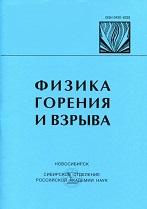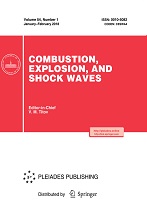|
This article is cited in 3 scientific papers (total in 3 papers)
Shock wave induced primary thermal fragmentation of coal particles
S. Jaisankar, D. M. Patadiya, T. S. Sheshadr
Institute of Science, Bangalore, 560012, India
Abstract:
Coal particles when subjected to shock waves can undergo rapid fragmentation, pyrolysis, and combustion, causing enhanced process intensity and efficiency. Particle fragmentation plays a crucial role in this process. Exposure of coal particles to a shock wave is modelled in the present work as combined convection and radiation at the surface and conduction in the interior. Local temperatures within a coal particle and the corresponding thermal stresses are computed to study particle failure. Particle fracture is modelled by a three-parameter Weibull probability to predict the failure location and time. Simulations indicate that pulverized coal of size up to $250$ $\mu$m subjected to a shock wave for varying operational, thermal, and physical parameters can experience initial failure within 150 $\mu$s. Particles of size $d\ge50$ $\mu$m or higher wave strengths (with Mach numbers $\mathrm{M}\ge 5$) mostly trigger exfoliation, while interior fragmentation dominates at smaller sizes ($d\le25$ $\mu$m). An initial fracture study reveals that pulverized coal with predominant sizes $d\le100$ $\mu$m and the coal rank from lignite to bituminous coal is potentially suitable for detonation combustion in waves at Mach numbers $\mathrm{M}=3-6$. Coal particles under continuous exposure to post-shock conditions undergo recursive exfoliation until the core is $20$–$40$ $\mu$m, after which an interior fragmentation phase is seen until the core is about $1$–$3$ $\mu$m. Much finer coal particles, of the order of internal fragmenting cores, are hardly fractured due to low thermal stresses caused by rapid uniform heating. The fracture model approach for studying shock-induced combustion is validated by a reasonable match of the computed ignition delay with experiments. The fragmentation history indicates a substantial increase in the particle surface area and temperature under shock exposure, as against conventional combustion, leading to an increased order of the burning rates at the onset of ignition, which can sustain through the entire burning phase.
Keywords:
particle fracture, recursive failure, Weibull theory, fragmenting shrinking core, burning shrinking core, exfoliation, fragmentation combustion, detonation.
Received: 16.03.2016
Revised: 17.08.2016
Citation:
S. Jaisankar, D. M. Patadiya, T. S. Sheshadr, “Shock wave induced primary thermal fragmentation of coal particles”, Fizika Goreniya i Vzryva, 53:3 (2017), 93–105; Combustion, Explosion and Shock Waves, 53:3 (2017), 329–339
Linking options:
https://www.mathnet.ru/eng/fgv414 https://www.mathnet.ru/eng/fgv/v53/i3/p93
|


| Statistics & downloads: |
| Abstract page: | 21 | | Full-text PDF : | 4 |
|





 Contact us:
Contact us: Terms of Use
Terms of Use
 Registration to the website
Registration to the website Logotypes
Logotypes








 Citation in format
Citation in format 
